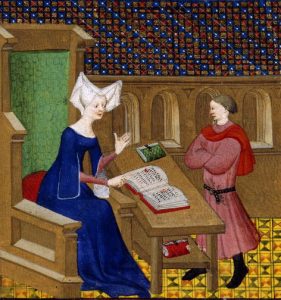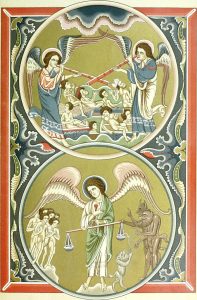3
Historical Context

When we talk about the position of women in any time period, it’s important to understand that there could be multiple perspectives. In looking at a time period in the distant past, it is more difficult to get a true sense of what the position of women actually was. What we think we know is determined by the reports that remain from that time period. Some of the questions we might ask, then, include the following:
- Who made the reports?
- What voices are not represented?
- Are the reports accurate?
- Is there any conflicting information?
When it comes to the medieval time period, the majority of writing comes from the Church and the aristocracy. In other words, “the ideas about women were formed on the one hand by the clerkly order, usually celibate, and on the other hand by a narrow cate, who could afford to regard its women as an ornamental asset, while strictly subordinating them to the interests of its primary asset, the land” (Medieval, 1). In other words, the only people who were writing about women were celibate priests and men of privilege whose wives served no clear purpose. For both of these parties, it made sense to place women in subjection to men.
It is important, then, to think about whose voices are not represented. In this case, we don’t hear what the common man had to say about women. In fact, the middle and lower classes might have something quite different to say than clerics and aristocratic males. We do have some records written by wealthier members of the middle class, whose “views on women betrayed a better understanding of women’s real position in medieval life…Town law had to take account of women active in trade, ore particularly, of married women carrying on trade on their own, as femmes soles” (Medieval, 2). In other words, the literature of men of business had to reflect the reality of women business owners. For the lower classes, too, women were not merely ornamental—they worked alongside men in the fields and factories.
Of course, the most important voice of all is the voice of women. It is very rare to find the words of women from this period, but they do exist. Women wrote love letters (Heloise, who was married to Peter Abelard) and poetry (Countess Beatrice of Die and Marie de France). Nuns and women mystics, like Teresa de Avila and Julian of Norwich, wrote about their experiences with God. Christine de Pisan was a writer “determined and able to plead for her sex, and to take a stand against the prevalent denigration of women” (Medieval, 4).
- Here is an interesting list of medieval women, ranging from authors to religious icons to rulers: http://www.medievalists.net/2011/09/medieval-women/
These varying perspectives become clear in the legal views of women, who could hold property, but whose husbands were legally allowed to beat them. Both the cult of the Virgin Mary and chivalry are born out of the views of the Church and the aristocracy, respectively. Both become vital for proper behavior: “In chivalry the romantic worship of a woman is as necessary a quality of the perfect knight as the worship of God” (Medieval, 12). Interestingly, the great love poems and courtship that came out of the notion of chivalry did not occur in the context of marriage: “it was based on the conviction that affection biding married persons—though real and valuable—had nothing in common with the sentiment of love, which might, and indeed must, therefore, be sought outside marriage” (Medieval, 15-16). Rather than shifting the views of women in marriage (which saw a wife as a means to gain/hold/pass on land), the idea of love was placed outside of marriage. Remember, though, that this mostly applied to the aristocracy: “the exaltation of the lady was the exclusive ideal of a small aristocratic caste,” and did not change the reality of a woman’s life.
It is important to keep in mind that, even when we take into account these varied perspectives, the literature may not be an accurate account of the actual daily lives of women. “A social position is never solely created by theoretical notions; it owes more to the inescapable pressure of facts, the give and take of daily life. And the social position which these facts created in medieval society was neither one of superiority nor of inferiority, but one of rough and ready equality. For in daily life man could not do without woman; he relied on her for the comfort of his home, and much more than at many other periods in history he relied on her to look after his affairs in his absence from home” (Medieval, 26). We have to remember that the reality of individual women’s lives did not always reflect the position given to them by literature.
Medieval Literature

As we read these varied sources about and, rarely, by women, we begin to see some interesting trends. From a society where women legally had no rights, we see tales of the hen-pecked husband who is ruled by his wife, as well as an understanding that “all his orders, just and unjust, important and futile, reasonable and unreasonable, must be obeyed” (Medieval, 8). From the Church came depictions of women either as the villainous Eve, an “instrument of the Devil” or “supreme temptress” or the virtuous Mary.
In literature, we find that these ideals are made larger than life, but they were short-lived. Courtly love degenerated into courtly flirtation, which ended up placing women in greater danger. Once the idea of courtly love faded, attacks against women increased and we see in the rhymed anecdotes that become popular at this time that “the old are all evil-minded hags, the wives all betray their husbands, the girls are either minxes or fools” (Medieval, 20). Interestingly, we also see literature from this time that contradicts these views. Many are anonymous, but this is where we find Christine de Pisan, who “compiled tales to illustrate the virtues of women” (Medieval, 24).
Additional Resources
- Jordan, Rosan A., and F. A. De Caro. “Women and the Study of Folklore.” Signs, vol. 11, no. 3, 1986, pp. 500–518. JSTOR, www.jstor.org/stable/3174007. (Click link to read. Available from the YC Library Databases, so you should be able to find it if the link doesn’t work for some reason.)
- The Challenge of Folklore to Medieval Studies (John Lindow)
- ” Medieval Women. Cambridge: Cambridge Univ. Press, 2000. (Print copies of the entire book available at the YC and Prescott Libraries)
Unless otherwise noted, content created by Dr. Karen Palmer and licensed under CC BY NC SA.
Media Attributions
- Christine_de_Pisan_and_her_son
- Science_and_literature_in_the_Middle_Ages_and_the_Renaissance_(1878)_(14764381812)
